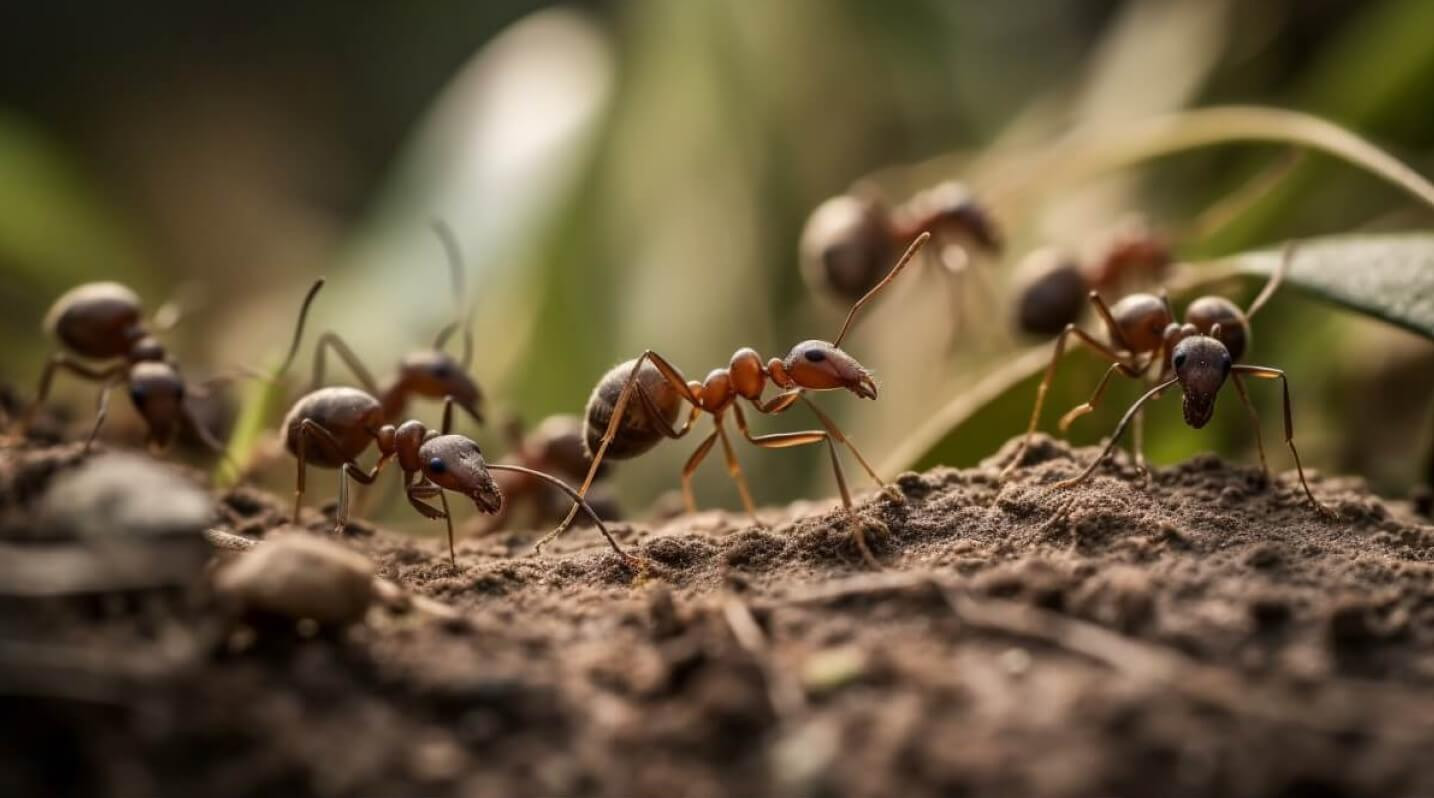Would you prefer to listen to a short podcast discussion about this article? Click on the audio below.
Ants are one of the most prevalent and diverse insects found worldwide, and the UK is no exception. While ants are tiny, they significantly impact the environment and can cause issues when they invade homes and gardens. In this article, we will take a closer look at the different species of ants found in the UK, their behaviour and social structure, and their impact on the ecosystem. We will also explore the ants’ challenges and how they can be managed through prevention and control measures.
Table of Contents
Introduction
The ant is a common sight in gardens and countryside across the UK, forming an important part of our ecosystem. These fascinating insects can be found in a variety of shapes, sizes and colours and are well-known for their ability to work together in highly organised colonies. In this article, we’ll look closely at ants’ anatomy and life cycle, explore the different species found in the UK, and examine their social behaviour and hierarchy.
What are Ants, and Why are They Important?
Ants are social insects belonging to the family Formicidae, which includes over 12,000 species worldwide. They are important for maintaining a healthy ecosystem, as they are vital in soil aeration, seed dispersal, and pest control. Ants are also known to be efficient cleaners, removing dead insects and decaying plant matter from the environment.
Anatomy and Life Cycle of The Ant
Physical Characteristics of an Ant
Ants are easily recognised by their narrow waists, elbowed antennae, and powerful jaws. They have a hard exoskeleton, which protects their body and provides support. They are incredibly adaptable and have evolved to suit a wide range of environments, from deserts to rainforests.
Stages of Ant Development
An ant undergoes complete metamorphosis, which means they have four distinct stages of development: egg, larva, pupa, and adult. Eggs are laid by the queen ant and are cared for by the workers. The larvae hatch from the eggs and are fed by the workers until they pupate. Finally, the adult ant emerges from the pupal case after a development period.
The Role of Queen Ants
A Queen ant is responsible for laying eggs and maintaining the colony. They can live for several years and lay hundreds of eggs daily. The workers feed and care for the queen, as she is essential for the colony’s survival.
Species of Ant Found in the UK
Common Ant Species
The black garden ant is the most common in the UK (Lasius niger). They are typically found in gardens and parks and are known to build large nests under paving stones and lawns. Other common species include the red ant (Myrmica rubra) and the yellow meadow ant (Lasius flavus).
Uncommon Ant Species
Less common species in the UK include the wood ant (Formica rufa), which builds large nests in woodland areas, and the slave-making ant (Formica sanguinea), which raids the nests of other ant species and enslaves its workers.
Ant Nesting Habits
Ants build their nests in a variety of locations, including soil, leaf litter, and tree trunks. Some species, like the wood ant, build their nests in trees and can be seen carrying leaves back to their colony.
Ant Behaviour and Social Structure
Ant Communication Techniques
The ant uses a variety of methods to communicate with each other, including chemical signals, touch, and sound. They can detect chemical signals other ants leave, allowing them to follow trails and locate food sources.
The Role of Ants in the Colony
Ants have a highly organised social structure, with each individual performing a specific task contributing to the colony’s survival. For example, worker ants are responsible for tasks like building the nest, foraging for food, and caring for the young.
Ant Colony Hierarchies
Ant colonies have a hierarchical structure, with the queen ant at the top and the workers at the bottom. The queen is responsible for laying eggs and is cared for by the workers. Some species also have soldier ants accountable for defending the colony against threats.
The Ant in the Ecosystem: Importance and Impact
The ant plays an important role in the ecosystem as they aerate the soil, control pest populations, and disperse seeds. They are also a food source for other organisms, such as birds, reptiles, and mammals. In addition, ants are known for their ability to form complex societies and their role in nutrient cycling. Overall, they contribute to the overall health and maintenance of the environment.
Ecological Functions of The Ant
Ants help in the decomposition of organic matter, pollination, and soil formation. They also enhance plant growth by dispersing seeds.
The Ant as a Food Source for Other Organisms
Ants serve as a nutritious food source for many animals, including birds, lizards, and mammals. Ants also help regulate other insect populations, which helps maintain the ecosystem’s balance.
The Impact of Ants on the Environment
Ants can be both beneficial and harmful to the environment. Some ant species can cause damage to crops or structures, while others help to control pest populations. Additionally, introduced ant species can disrupt native ecosystems and threaten biodiversity.
Threats and Challenges
Due to environmental changes and human impact, an ant faces several threats, including invasive species, loss of habitat, and pollution.
Invasive Species
Invasive ant species like the Argentine ant can displace native species and dominate their habitats. These invasive species can also have a negative impact on the environment by disrupting the ecological balance.
Environmental Changes
Changes in land use, deforestation, and climate change can lead to a loss of habitat for ants. This loss of habitat can have a significant impact on ant populations, as well as the other organisms that rely on them.
Human Impact on Ant Populations
Human activity, such as using pesticides and herbicides, can hurt ant populations. In addition, pollution from chemicals and waste can also threaten ant habitat and food sources.
Managing Ant Infestations: Prevention and Control Measures
Preventing and managing ant infestations is important for the environment and human health. In the UK, there are several non-toxic and chemical control methods available.
Preventing Ant Infestations
Simple preventative measures such as cleaning up spills and removing food sources can help prevent ant infestations. Sealing cracks and gaps in homes can also prevent ants from entering.
Non-toxic Ant Control Methods
Non-toxic control methods, such as bait stations and diatomaceous earth, can effectively control ant populations without harming the environment.
Chemical Ant Control Methods
Chemical control methods, such as insecticide sprays, can be effective but should be used cautiously as they can harm the environment and other organisms.
Conclusion and Future Prospects for UK Ants
Ants are an important part of the ecosystem, and their role should not be overlooked. While the UK and its populations face several challenges and threats, proper management and conservation measures can help protect them.
Current State of Ant Populations in the UK
Currently, over 50 species of ants are found in the UK, with some species being more common than others. The distribution and abundance of these species can also vary depending on the region.
Possible Future Developments in Ant Research
Future research may focus on the impact of invasive species, the role of ants in ecosystem processes, and the development of new, non-toxic control methods. Additionally, conservation efforts may be needed to protect threatened ant species in the UK. In conclusion, ants are fascinating insects that are essential to the UK’s ecosystem. While they can be a nuisance when they invade homes and gardens, various non-toxic and chemical control methods are available to manage infestations. By understanding their behaviour and social structure, we can also appreciate these tiny creatures’ importance and impact on the environment.
Frequently Asked Questions (FAQ)
What is the most common species of ant found in the UK?
The UK’s most common species of ants is the black garden ant (Lasius niger), found in gardens, woodlands, and other outdoor spaces.
How can I prevent the ant colony from invading my home?
One of the best ways to prevent ants from invading your home is to keep it clean and free of food debris. Sealing cracks and crevices and fixing leaky pipes can also help to prevent ants from entering your home.
Are ants harmful to the environment?
They play an essential role in the environment, and their presence can benefit soil health and plant growth. However, some invasive ant species can cause harm to native plants and animals, such as the Argentine ant, which competes with other ant species for resources.
What should I do if I have an ant infestation in my home?
If you have an ant infestation in your home, it’s crucial to identify the species of ant and their nesting location. To manage the infestation, you can then use non-toxic or chemical control methods, such as bait stations or insecticides. In severe cases, consulting with a pest control professional may be necessary.
If you require any assistance with this article, please do not hesitate to Contact Us





















